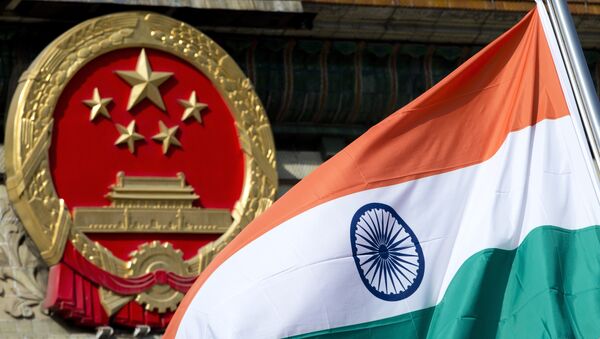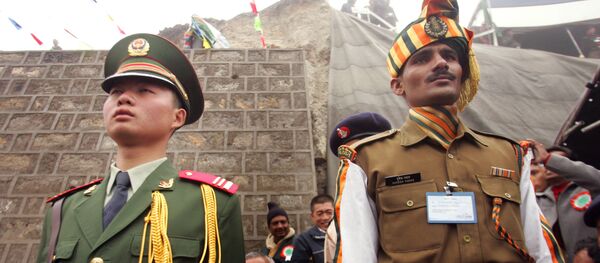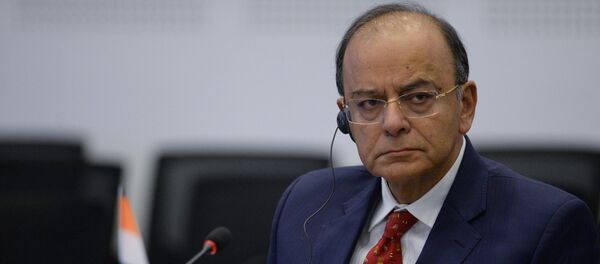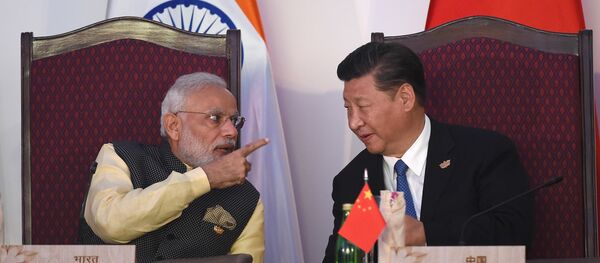Last month, Indian troops crossed into the area with bulldozers in an attempt to prevent Chinese troops from constructing a road in Yadong county.
Photos of the mid-June incident released by the Chinese Ministry of Foreign Affairs on June 29 show Chinese soldiers trying to halt the Indian forces which had crossed a crest which China says defines the boundary between the two nuclear powers.
The southern Tibet border region has long been the site of territorial disputes between China, India and Bhutan. More broadly, the Sino-India border remains China's largest unresolved land territorial dispute, covering thousands of kilometers of boundary in the west and south of Tibet. Face-offs between border guards occur occasionally along the line.
"We once again urge the Indian side to abide by the existing boundary convention, respect China's territorial sovereignty, and immediately bring the border troops that have crossed into China back to the Indian side of the boundary, so as not to worsen the situation and land itself in a more passive position," Chinese foreign ministry spokesperson Lu Kang said at a June 29 press conference.
The Bhutanese government claimed on June 29 that China's road construction had occurred on its territory.
The Indian Ministry of External Affairs released a statement on the issue on June 30 in which it reiterated Bhutan's territorial claims, argued the road "would represent a significant change of status quo with serious security implications for India" and called for the peaceful resolution of the issue.
However, the Chinese foreign ministry has said that the location of latest skirmish is in an "undisputed" area the status of which has been "recognized by the Indian government repeatedly in writing."
Contradicting their own government, the Indian media said that China "transgressed" into their territory.
Many Chinese have called for a stern response. "Tolerance and weakness will only foment the Indian army's threatening manner. If Indian troops cross the border, Chinese soldiers should forcibly drive them away and fire if the efforts to dissuade them fail," said a Weibo user named Tangshan Jianke.
"We ask the Indian side to withdraw their intruders and investigate the incident thoroughly. If the Indian soldiers don't listen, we should take all necessary actions," said another.
Sun Shihai, honorary director of the Institute of Indian Studies, China (Kunming) Institute of South and Southeast Asian Studies, commented that the public outcry is understandable.
"Conflicts between Chinese and Indian border soldiers in the undisputed Sikkim section are rare," he told the Global Times. "But the use of force is not recommended. Both sides have agreed not to use military power to solve the border dispute. Both are nuclear powers, any kind of war will result in unthinkable consequences."
Following the incident, both India and China have strengthened their presence in the area, deploying around 3,000 troops each, according to The Times of India.
Purposeful provocation?
The recent face-off was first revealed by The Times of India with a 140-second video on June 26, showing Indian soldiers jostling with their Chinese counterparts.
The Times claimed that they obtained the video from a source who said the video was taken around 10 days prior to their report. The newspaper also claimed that Chinese soldiers "transgressed" into Indian territory along the border in Sikkim and that they were "aggressive" and "pushing the Indian troops."
The newspaper quoted the source as saying that Chinese troops had destroyed two Indian Army bunkers nearby after crossing the border.
The report, published shortly after Indian Prime Minister Narendra Modi landed in Washington DC to begin a three-day visit to the US, soon circulated on Chinese social media and aroused great concern.
Many alleged that India wanted to show its "strategic value" to the US through "suppressing China." "India's provocation is possibly a gift to the US, so as to raise their bond and let the Americans feel that it can be their ally," one Weibo user said.
Zhicheng Dabing, a military commentator with about 150,000 fans on Sina Weibo, believes that the Indian troops must have received high-level orders to challenge China in Doklam. "From my experience, the case is neither accidental nor arbitrary trouble made by some border guards. Without the 'direction' of upper-level officials, the grass-roots soldiers wouldn't be so aggressive," said the commentator in an opinion piece that has attracted thousands of views.
Indian studies expert Sun Shihai, said intentional Indian provocations in the disputed border are rare. "But it doesn't rule out the possibility that the Indian Army wanted to demand more money by stirring up a confrontation, exaggerating the China threat," Sun noted.
Indian Defense Minister Arun Jaitley explained that India was "giving protection" to Bhutan as "China is trying to encroach on Bhutan's land," according to India Today. However, Beijing maintains that Doklam has been a part of China since ancient times. "That is an indisputable fact supported by historical and jurisprudential evidence, and the ground situation," said Chinese foreign ministry spokesman Lu Kang.
Peaceful process
As Beijing and New Delhi have increased patrols and construction of infrastructure in disputed regions in recent years, physical confrontations between their militaries — and their publication by the Indian media — have become more common.
In October 2015, Indian TV station NDTV broadcast a 2-minute video showing a dozen soldiers jostling and accusing each other of trespassing.
In August 2014, a longer video shot from the Indian side was posted online, showing dozens of armed Indian border soldiers pushing and quarrelling with their Chinese counterparts along a wall of stones.
"On the border disputes, New Delhi revealing them and then speculating and smearing Beijing has become a habit," said Jiang Jun, a researcher from the China Institute of Cyberspace Strategy, in a commentary recently published in the Global Times.
China and India have previously agreed that the disputes must be solved diplomatically. During the visit of the then Chinese Premier Wen Jiabao to India in 2005, Beijing and New Delhi signed a historic accord, agreeing to settle the decades-old border dispute without use of force.
In 2013 when the then Indian Prime Minister Manmohan Singh visited China, the two states signed the Border Defense Cooperation Agreement, reaffirming that both shall "exercise maximum self-restraint," "not use force or threaten to use force" and "prevent exchange of fire or armed conflict" when face-offs occur along the disputed areas.
Thanks to the mechanism, the confrontations in recent years have always ended peacefully. The soldiers from both sides have also reportedly gathered to celebrate the New Year along the border areas.
A Chinese frontier soldier serving in Tibet told the Global Times that they confront their Indian counterparts often but they have rules and mechanisms to resolve these standoffs.
"Eyeball-to-eyeball confrontations often happen when we meet them while patrolling. But we try our best to avoid physical contact or scuffles. We don't use weapons. There are also special people who can speak English who are in charge of communication," he said.
He also said when they discover shelters built by Indian patrols in disputed areas they dismantle them when the Indians leave.
This article was originally published by the Global Times.








